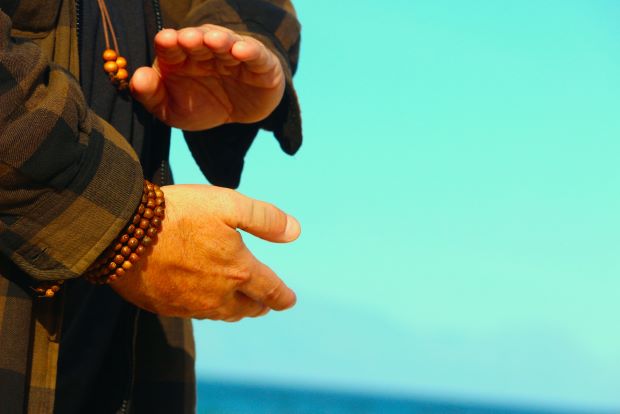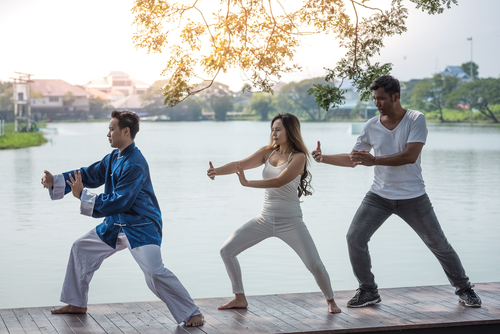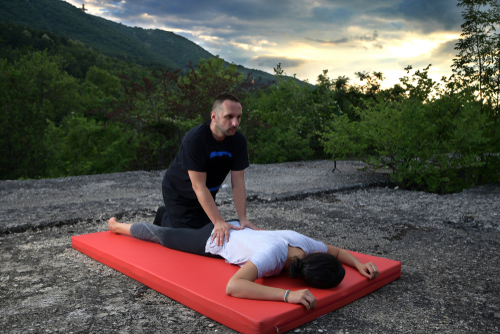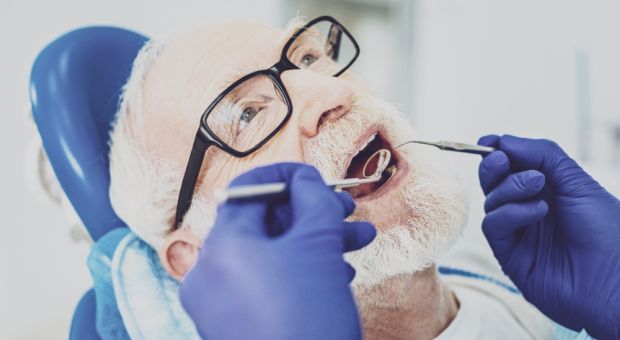Many people today are very unhappy with a medical industry that costs a fortune and delivers only addictive drugs for pain management.
While many doctors claim QiGong, Yumeiho, and other alternative treatments are nonsense, people in pain are increasingly ignoring the doctors and researching on their own. Let’s have a look at just how good or bad QiGong and Yumeiho are in terms of evidence based research results.
What is QiGong?
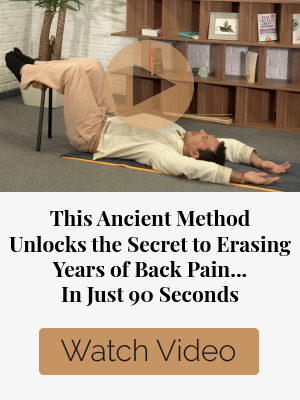
No matter whether this form of energy is referred to as Chi, Prana, or Qi, the outcome is the same. When this life energy is flowing properly in the body, then you will be in good health. When the flow is disrupted or uneven, then you will get sick or experience pain. QiGong is a system of mediation and motion that allow you to redirect the flow of energy to restore health.
How it Works
At its simplest, Qi Gong is the manipulation of an unseen energy (Chi) that moves through our body and everything around us. It is one system of many that can be used for healing or other purposes.
There are three basic types of Qi Gong[1]:
- Medical Qi Gong – there are two components to this type. First, a practitioner may send qi through the palms of their hands into the patient. If this sounds strange to you, consider that laying on of the hands has been used for centuries in Christian churches, therapeutic touch,[2] and Reiki also rely on “unseen” or “non-scientific” energy transfers. It is also important to note that “energy transfer” of these kinds are actively and openly being used in the medical field. For example, studies done 2008 or later show that Reiki[3] is effective for pain management. It is used by nurses, and some hospitals[4] have programs, or allow practitioners[5] to come in and give reiki to patients for free.
The second part of medical Qi Gong is carried out by the patient. It is commonly used in hospitals in China where patients are encouraged to use different postures and motions to accelerate healing. People can also use these exercises as directed at home, in classes, or at the direction of a Qi Gong practitioner.
- Meditation Qi Gong – Regardless of whether you are looking at Indian or Asian cultures, Chi or Prana is usually cultivated by using different postures and breathing routines combined with meditation. In a similar fashion, Meditation Qi Gong also utilizes postures and meditations aimed at improving health.
- Martial Qi Gong – this form of Qi Gong is usually used for improving strength and endurance. You would find this form used more in the marital arts as opposed to for the purpose of improving health.
How Accurate are the Claims Against It?
People that insist evidence based medicine must come from scientific laboratories often forget that you can’t rule something out if you haven’t studied it using a proper research method. Quite frankly, the arguments against Qi Gong are similar to the arguments against the existence of God. Just because you don’t actually know how to study something or haven’t actually studied it correctly (as is the case of Qi Gong) that doesn’t mean it doesn’t work. It simply means you haven’t got the proper foundation yet to develop the correct experimental research design.
Saying that something doesn’t work because you haven’t studied it correctly is just as short sighted as claiming it does. So where does that leave us? We can look to the history of these systems. Yoga, Ayurvedic medicine, and TCM were all developed over hundreds to thousands of years of human history.
One must ask this. If they were such a failure, why weren’t they abandoned by the cultures that developed them? Perhaps it is our scientists that must learn more about the history of these energy systems and how they were discovered so that they can develop more meaningful and appropriate experiments. For the moment, even with their sad lack of insight, their own studies are showing that Qi Gong and Tai Chi[6] are effective for some forms of pain management. If you want to use Qi Gong for back pain management, there is likely no harm in it provided you find a good instructor to help you along.
What is Yumeiho?
Even though Yumeiho Therapy[7] was only invented in the 1970’s or 1980’s, it looks a lot like a blend of chiropractic manipulations and massage. The system itself was developed by Dr. Saionji Masayuki after several decades of private research into ancient or old medical healing texts from China and other countries. Right now, there are Yumeiho centers in over 73 countries and a number of teaching facilities.
Many people think that Yumeiho probably won’t do any harm, even if it does no good. On the other side of the equation, chiropractic manipulation[8] can certainly cause harm if it is done incorrectly. In a similar fashion, there is a huge difference between the kind of deep body massage you may get in a Yumeiho session and a relaxing back rub. The former can cause damage, especially for people that have cancer or other conditions that increase the risk of internal injury or bone breakage.
Insofar as finding a good practitioner, you will need to rely on the website for the founding members. If you consult the “rules” page[9] , you will see that it can take some time for a practitioner to be skilled enough to treat patients. Elsewhere on the site, you can also learn more about centers located throughout the world and training programs.
Depending on where you live, you may find doctors as well as other practitioners that claim they are certified in Yumeiho. Before you believe them, ask to see their diploma. Be sure to make note of the year it was signed as well as any information about the facility that credentialed the practitioner. From there, you can try to contact the foundation group in Japan and ask if they have ever heard of practitioner. Remember, when pain is involved, you are bound to find people that want to make money on something that is relatively unknown or is gaining rapidly in popularity.
How it Works
Unlike Qi Gong, Yumeiho doesn’t necessarily focus on energy flow through the body. Rather, it relies on a number of elements that include:
- Bone and muscle manipulations to achieve balance. According to practitioners, everyone’s hips, in particular, are out of alignment because of the birth process. Yumeiho seeks to put the hips back into alignment and any other parts of the skeleton that may have been disrupted over time because of this initial problem.
- Yumeiho also includes breathing and relaxation exercises to help maintain good health.
- Practitioners of Yumeiho may also use massage and reflexology to help alleviate pain or prevent chronic disease.
- Finally, Yumeiho also helps you focus on good posture and gait. While this is often used to prevent all kinds of illness, good posture and gait training can also go a long way to helping alleviate back pain.
How Accurate are the Claims Against It?
Because Yumeiho is very new, there is little, if any research done on it. There is some evidence that Yumeiho was successfully used to treat headaches[10]. If you research individual components of Yumeiho like chiropractic manipulation and massage, you are bound to find many studies that indicate they are useful for treating and managing back pain as well as other medical problems.
As with Qi Gong, it is not possible to say scientifically whether or not it will work to treat back pain. Lack of research doesn’t mean it won’t work, it just means researchers haven’t studied it enough to know one way or another.
When it comes to calling a system that has been used for hundreds to thousands of years “quackery” it helps to have hundreds of studies to prove that kind of statement. Clearly, two contradictory studies on Qi Gong do not qualify for making this kind of claim. While they don’t prove that Qi Gong works from a scientific perspective, they don’t disprove it either.
At the end of the day, if you are interested in using either Qi Gong or Yumeiho for back pain, it is best to seek advice from certified individuals. To find a qualified person to help you with Qi Gong, it might be best to visit a dojo or other location where marital arts are taught. Since most, if not all martial arts systems work with Chi, they are the people most likely to know of a practitioner skilled in the medial manipulation of Chi. In a similar fashion, if you wish to use Yumeiho, it is best to visit the main website and see if you can find a certified center in your area.
Resources
[1] http://www.taichisociety.net/difference-between-tai-chi-qigong.html
[2] https://www.ncbi.nlm.nih.gov/pubmed/3633503
[3] https://www.ncbi.nlm.nih.gov/pmc/articles/PMC4147026/
[4] https://www.washingtonpost.com/national/religion/reiki-goes-mainstream-spiritual-touch-practice-now-commonplace-in-hospitals/2014/05/16/9e92223a-dd37-11e3-a837-8835df6c12c4_story.html
[5] https://www.abmp.com/news/reiki-program-veterans-ptsd-receives-state-funding
[6] https://nccih.nih.gov/health/taichi/introduction.htm
[7] http://www.yumeiho.eu/about.php
[8] https://www.mayoclinic.org/tests-procedures/chiropractic-adjustment/about/pac-20393513
[9] http://www.yumeiho.eu/rules.php
[10] https://www.ncbi.nlm.nih.gov/pmc/articles/PMC3312646/


